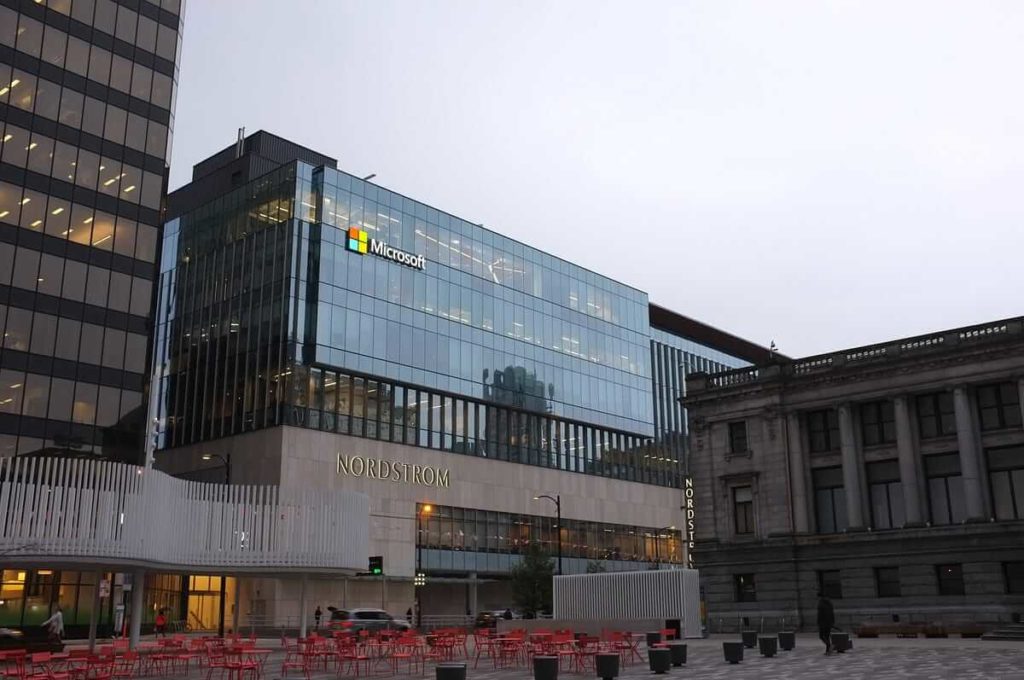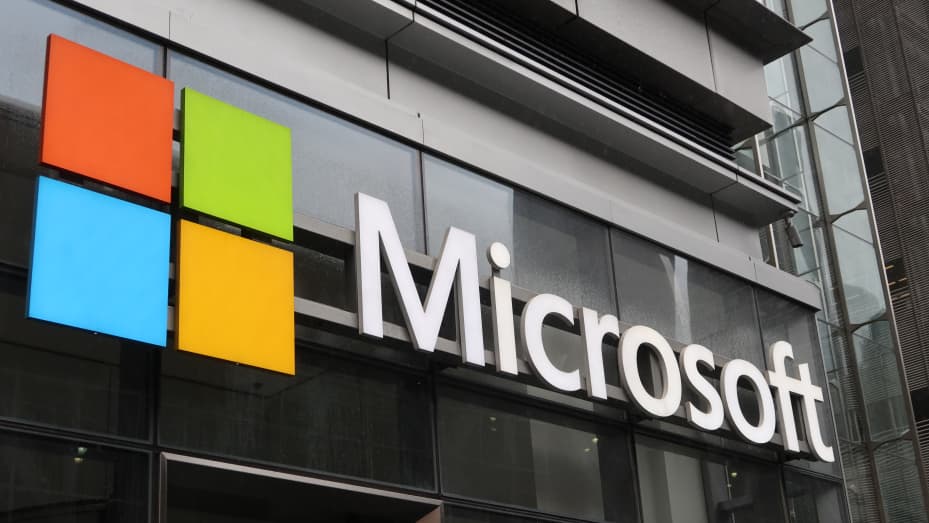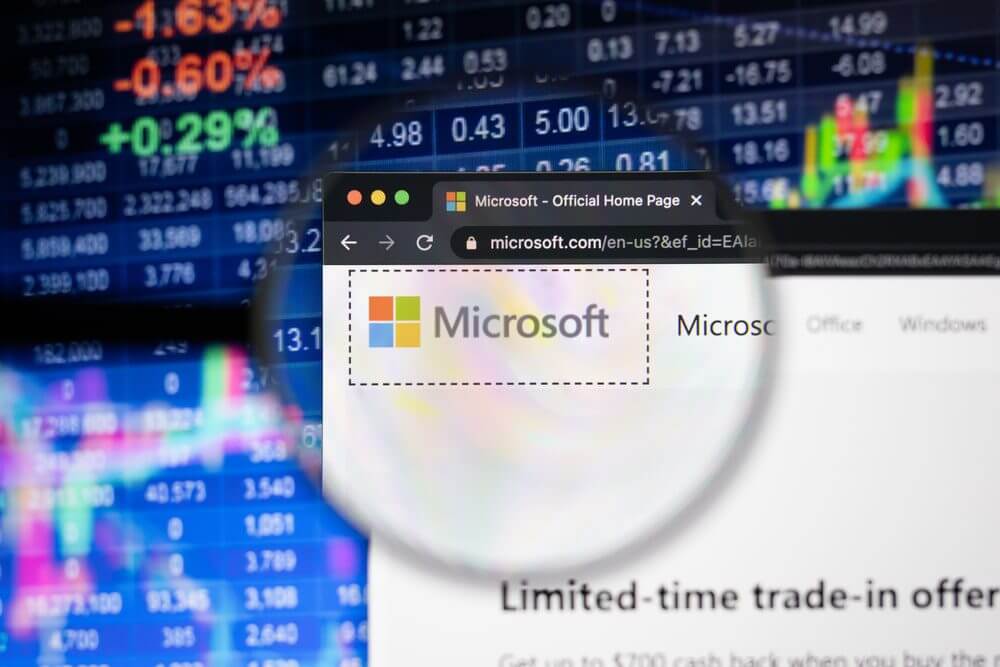Microsoft is a technology company whose projects span hardware, software, the cloud, and everything else. It offers business-oriented server tools for video games and free web content.
The corporation has subsidiaries in over one hundred countries. -Microsoft’s facilities in King County, Washington, consist of approximately 10 million square feet of owned space on 520 acres of land, plus an additional 5 million square feet of leased space.

Microsoft has extensive research and development centers in China and India, data centers in Ireland, the Netherlands, and Singapore, and operations facilities in Ireland and the United Kingdom. It employs over 144,000 people, including over 85,000 in the United States.
This file photo from July 3, 2014, shows Microsoft Corp. signage in front of the Microsoft Visitor Center in Redmond, Washington. (Associated Press Photograph by Ted S. Warren, File / Associated Press). Don’t forget to check out our article on the Rise and Fall of Meta before we continue and delve deeper into the Microsoft industry.
Table of Contents
ToggleCompany Size of Microsoft Corp
Microsoft is a technology giant that operates in every industry area, from computer hardware to computer software to cloud computing.
Its vast catalog features everything from server tools for businesses to games and free web content. Company branches can be found in over a hundred different nations.

About 10 million square feet of space is available at Microsoft’s King County, Washington facilities, spread across 520 acres of land the company owns.
Another 5 million square feet is available through leasing. Datacenters in Ireland, the Netherlands, and Singapore, as well as operations centers in Ireland and the United Kingdom, are just some of Microsoft’s international facilities.
More than 144,000 people are employed by it, with 85,000 in the United States. The file photo was taken on July 3, 2014, of Microsoft Corp. billboards in Redmond, Washington. (File photo by AP photographer Ted S. Warren).
Microsoft Financials

MSFT is the ticker symbol for Microsoft stock on the Nasdaq. A dividend of $0.51 per share is distributed every three months.
The company announced in July that its net profit for the fiscal year totaled $36.8 billion, up 21.6% from the previous year. This year marked the first time in history that Microsoft Corp was worth more than $1 trillion.
Microsoft’s success over the past two years can be mainly attributed to the company’s investment in cloud computing.
The company forecasts double-digit percentage increases in revenue and operating profit for the current fiscal year.
Company Leadership
Microsoft’s CEO is Satya Nadella. He has been with Microsoft Corp since 1992 and has served in various executive capacities in business and consumer divisions.
Recently, he oversaw the expansion of Microsoft’s cloud infrastructure as vice president of the company’s cloud and enterprise group.
Nadella is also a member of the Starbucks board of directors and the board of trustees at the Fred Hutchinson Cancer Research Center.
On Wednesday, December 3, 2014, in Bellevue, Washington, Microsoft CEO Satya Nadella addressed shareholders at the company’s annual shareholders meeting.
Nadella attended his first Microsoft annual meeting as CEO. Photo by Ted S. Warren for AP. In addition, Microsoft is governed by a board of 14 directors.
Bill Gates, the company’s founder, served as chairman of the board from 2000 to 2014 and continues to serve on the board today.
PepsiCo, Bank of America, and Marriott International executives are among the board’s members.
Founding and early growth
Bill Gates and Paul G. Allen, two Seattle natives and childhood friends, ported the widely used programming language BASIC from mainframe computers to the pioneering personal computer Altair in 1975. Microsoft Corp, which Gates and Allen named after a combination of “microcomputer” and “software,” was founded shortly after. Over the subsequent years, they made numerous enhancements to BASIC and created several new programming languages.
In 1980, IBM commissioned Microsoft to develop the primary piece of software—the operating system—for its groundbreaking PC. Microsoft originally purchased and modified an operating system developed by another company (Microsoft Disk Operating System) for its MS-DOS operating system. In 1981, Microsoft released MS-DOS alongside the IBM PC. Microsoft Corp made a fortune when PC makers began licensing MS-DOS as the standard operating system for their products.
By the early 1990s, the company had sold over 100 million copies of MS-DOS, replacing older operating systems like CP/M and later IBM OS/2. Windows, Microsoft’s graphical user interface (GUI) that debuted in 1985 and saw its third major revision in 1990, solidified its dominance in the operating system market. One million copies of Windows 3.0 and later versions were sold monthly by 1993. By that year, Microsoft’s operating system was installed on nearly 90% of all personal computers worldwide.
Released in 1995, Windows 95 was the first version of Windows to feature full MS-DOS integration, making it competitive with Mac OS in terms of user-friendliness. Microsoft Corp also surpassed longtime competitors Lotus and WordPerfect to become the market leader in productivity software. -This includes word processors and spreadsheet programs. Microsoft’s electronic publishing division launched in 1985 and most famous for its multimedia encyclopedia Encarta, underwent a massive expansion.
Microsoft Network and MSNBC
The Microsoft Network and MSNBC are just two of the many products and services it offers in the information services and entertainment industries, which it has recently entered (a joint venture with the National Broadcasting Company, a major American television network that began in 1995 and ended in 2012). Microsoft, which went public in 1986, became one of the most influential and successful corporations in U.S. history by the mid-1990s. Profit margins of 25 cents per dollar of sales were maintained consistently.
The company’s net income first topped $2 billion in the 1996 fiscal year, and it had continued to grow steadily ever since, even through the Great Recession of 2007–2009 (when it had reached more than $14 billion). Competitors were envious of the company’s success in a short time, and some even claimed that the company was breaking the law by engaging in such predatory business practices. However, Microsoft and its supporters argued that the company’s rise had stoked technological innovation and increased competition, resulting in Microsoft’s software becoming cheaper and more valuable over time.
In 1994, following an investigation by the U.S. Justice Department, a settlement was reached in which Microsoft agreed to alter its sales practices to prevent customers from being unfairly discouraged from trying out competing for operating systems. The Justice Department successfully challenged Microsoft’s attempt to acquire Intuit Inc., the market leader in PC financial software, the following year.
Chasing the Internet
Microsoft’s stunning success with PC software may have delayed the company’s recognition of the commercial potential of network systems and the Internet. Its release of Windows NT in 1993 was a watershed moment in computer history because it allowed users to connect previously isolated PCs and enjoy the benefits of increased stability and safety in their networks.
Despite slow beginnings in the marketplace, by 1996, Windows NT had become widely recognized as the most promising networking standard for personal computers, quickly overtaking Novell’s NetWare. Microsoft didn’t get into the Internet software business until a new company, Netscape Communications Corp., released a product called Navigator, which made it easier to browse the Web.
Microsoft abruptly changed directions, developing and releasing its browser, Internet Explorer, and aggressively lobbying PC manufacturers and ISPs to distribute it exclusively. By 1996, Microsoft had begun including Explorer as part of the Windows operating system and integrating Explorer into Windows.
In response, Netscape sued Microsoft for allegedly breaking the terms of the 1995 consent decree, which ultimately led to a renewed federal investigation of the software giant. After a 30-month trial in 1999, a judge ruled that Microsoft had violated the Sherman. The Antitrust Act of 1890 ordered the company to be divided up. An appeals court overturned the original 2001 breakup order, but the company was still found guilty of illegally attempting to maintain a monopoly.
Legal troubles for Microsoft persisted in 2004 when the EU slapped the company with its largest fine to that point, €497.2 million ($611 million), in response to the company’s near-monopoly tactics. Since Microsoft continued to defy the EU’s 2004 antitrust decision against it for illegally bundling multimedia software with its Windows operating system to exclude competitors, the EU increased the fine in February 2008 to €899 million ($1.35 billion).
Entry into the gaming and mobile phone markets
The Xbox, an electronic game console released by Microsoft in 2001, quickly rose to second place in the video game market. It introduced Xbox Live, a broadband gaming network for its consoles, in 2002. In 2005, Microsoft released the Xbox 360, an upgraded video game console. Microsoft has had a tough time making a consistent profit off the Xbox in a market with stiff competition from Nintendo’s Wii and Sony’s PlayStation.
When it came time to increase its market share in 2009, Microsoft did things like slashing the price of the Xbox 360 Elite by as much as 25 percent. In 2010, the Xbox 360 became the most popular home game console in the United States. However, Microsoft’s Entertainment and Devices Division saw a 6 percent decline in revenue due to the price cuts (EDD).
It took until 2013 for the Xbox One to replace the Xbox 360; by 2020, the Xbox Series X and Xbox Series S would do the same. Several competing EDD offerings also faltered. Despite being released in 2006, the Zune family of portable media players was discontinued the following year, in 2011, due to their inability to compete with Apple’s iPod.
Microsoft’s Windows Mobile operating system, found in HTC, LG, Motorola, and Samsung devices, came in third in U.S. sales after Research in Motion’s BlackBerry and Apple’s iPhone. Disc and web-based versions of Microsoft’s Encarta encyclopedia were discontinued in 2009.
Further developments in Windows OS
In 2001, Microsoft started working on a comprehensive plan to replace all its operating systems. The public’s growing concern with computer security and consumers’ desire for PCs to have greater integration with a full range of entertainment equipment in the modern electronic home contributed to many delays in developing the Longhorn project.
The company rebooted, and the rebranded Vista operating system was made available to third-party programmers at the tail end of 2006 and the public in 2007. Vista experienced difficulties due to incompatibilities with older computer hardware when first released. The new OS had a “bloated” structure, making running on less powerful hardware difficult. It needed a fast microprocessor and lots of RAM. Many businesses and individuals were discouraged from switching to more primitive operating systems like Windows XP (an abbreviation for “Windows Experience”) due to its strict requirements for a fully functional system.
Further, consumers were confused by Vista’s many editions (Home, Basic, Premium, Ultimate, Business, and others), while enterprise customers (Microsoft’s bread-and-butter) resisted the operating system due to its radical new user interface and reluctance to update their proprietary software to work with it. Microsoft’s enterprise customers remained on Windows XP for various reasons.
Although XP had its share of issues, it was much more secure than its predecessors. Business users were hesitant to switch to XP even though it was faster and more stable than Windows 95 or 98, and it ran tens of thousands of software programs written specifically for it. One possible explanation for Vista’s failure to catch on with corporate users is that users are simply happy with XP.
To appease their customers, PC manufacturers who Microsoft obligated to ship products with Vista offered “downgrades” to XP. Microsoft itself extended official support for XP to 2014, three years past its standard support policies. The rise of alternative operating systems has only added to Microsoft’s woes. Following the massive success of the iPhone and iPod, Apple’s Mac OS X gained traction among users.
Once an OS for the technically adept, Linux appeared in more user-friendly versions such as Ubuntu, and by the end of the first decade of the 21st century, Linux had captured one-third of the growing low-cost netbook market. Despite its market woes, Microsoft has maintained its position as the industry’s go-to OS provider. Depending on the study, Windows had between an 86% and 92% share of the global market.
Microsoft’s dominance has not wavered since Windows 7, the company’s replacement for Vista was released in 2009. Released in 2012, Windows 8 introduced a tile-based app launcher to the operating system. The release of Windows 10 in 2015 included the introduction of Cortana, a digital personal assistant that could respond to voice commands (like Siri on the iPhone), and Microsoft Edge, a new Web browser designed to compete with Chrome and Firefox.
Competition with Google
In contrast to its continued OS dominance and quick recovery in the “browser wars,” Microsoft’s Live Search lagged far behind those of Google Inc., the new industry giant, and Yahoo Inc., the long-standing Internet portal site. Microsoft’s 2009 release of Bing, a “decision engine” intended to display more retrieved information in search pages than was customary to help users make more educated decisions about which links to follow or, in some cases, provide enough information to satisfy the original query, was an attempt to alter the market’s equilibrium. Microsoft made a $44.6 billion offer to acquire Yahoo! in 2008, but Yahoo! declined.
Nonetheless, the two companies continued to talk, and in 2009, they reached an agreement under which Yahoo would use Bing on its website and manage Microsoft’s premium advertisements.
In 2015, the partnership was renewed with some adjustments (providing Yahoo with more leeway). After reaching an agreement with Yahoo!, Microsoft licensed content from Wolfram Research, developers of the Mathematica-powered WolframAlpha scientific search engine. Microsoft has entered cloud computing, where users access server-based applications and data is handled remotely over the Internet rather than locally on their computers, to better compete with Google.
Microsoft made its first move in 2010 with the release of its Windows Azure (since 2014, Microsoft Azure) cloud computing platform. Azure enables service providers and businesses to construct “cloud”-based computing infrastructure, which can then be made available to end users as a service.
Microsoft Office
To compete with Google Docs, Microsoft released Office 365 in 2011, a cloud-based version of its lucrative Office business software suite (including Word, Excel, PowerPoint, Outlook, and OneNote).
Skype
At the time of the purchase in 2011, Skype was the largest acquisition in Microsoft’s history, costing the company $8.5 billion. Thanks to Microsoft, Skype is now available on Windows phones, the Xbox 360, and Outlook. With the purchase of Skype, Microsoft now competes with Apple’s FaceTime and Google’s Voice for Internet calling.
In 2016, Microsoft made another massive acquisition when it paid $26.2 billion to acquire LinkedIn and a social networking site focused on professionals.
Microsoft after Bill Gates
Gates, a co-founder of Microsoft, handed over the company’s leadership to Steve Ballmer in the year 2000. Gates and Ballmer had met during Gates’ brief time spent at Harvard in the 1970s. In 2006, he gave up the position of chief software architect to Ray Ozzie, who had been instrumental in creating Lotus Notes, a computer networking program, in the 1990s. In 2008, Gates delegated management responsibilities to Steve Ballmer, Ray Ozzie, and the rest of the executive team, though he retained his position as chairman of the board.
After Ozzie’s departure in 2010, longtime Microsoft executive Satya Nadella succeeded Ballmer as CEO. -This was in 2014. Industry watchers worried (and hoped) that Microsoft’s dominance in the computer industry would suffer without Gates at the helm.
That outcome never came to pass. Operating systems, productivity software, and online gaming services are all areas in which the company has maintained its position as a market leader. Microsoft made history in 2012 when it introduced the Surface line of hybrid tablet computers that used hardware that Microsoft had developed in-house. It also offered products that could compete with the market leaders in virtually every IT and business software area.
Microsoft’s main competitive advantage and primary source of revenue came from its enterprise division, which established new benchmarks worldwide with its groundbreaking software. However, Microsoft’s leadership recognized that the company needed a sizable, if not dominant, presence in consumer markets as advancements in information technology continued to blur the line between personal computing and business computing.














